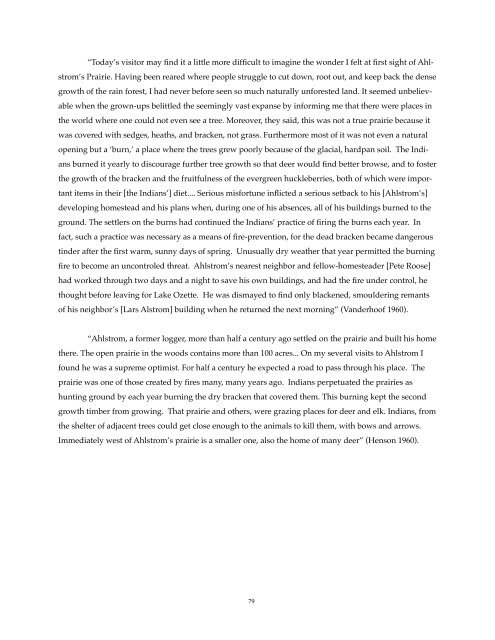The Ozette Prairies of Olympic National Park - Natural Resources ...
The Ozette Prairies of Olympic National Park - Natural Resources ...
The Ozette Prairies of Olympic National Park - Natural Resources ...
You also want an ePaper? Increase the reach of your titles
YUMPU automatically turns print PDFs into web optimized ePapers that Google loves.
“Today’s visitor may find it a little more difficult to imagine the wonder I felt at first sight <strong>of</strong> Ahl-<br />
strom’s Prairie. Having been reared where people struggle to cut down, root out, and keep back the dense<br />
growth <strong>of</strong> the rain forest, I had never before seen so much naturally unforested land. It seemed unbelievable<br />
when the grown-ups belittled the seemingly vast expanse by informing me that there were places in<br />
the world where one could not even see a tree. Moreover, they said, this was not a true prairie because it<br />
was covered with sedges, heaths, and bracken, not grass. Furthermore most <strong>of</strong> it was not even a natural<br />
opening but a ‘burn,’ a place where the trees grew poorly because <strong>of</strong> the glacial, hardpan soil. <strong>The</strong> Indians<br />
burned it yearly to discourage further tree growth so that deer would find better browse, and to foster<br />
the growth <strong>of</strong> the bracken and the fruitfulness <strong>of</strong> the evergreen huckleberries, both <strong>of</strong> which were important<br />
items in their [the Indians’] diet.... Serious misfortune inflicted a serious setback to his [Ahlstrom’s]<br />
developing homestead and his plans when, during one <strong>of</strong> his absences, all <strong>of</strong> his buildings burned to the<br />
ground. <strong>The</strong> settlers on the burns had continued the Indians’ practice <strong>of</strong> firing the burns each year. In<br />
fact, such a practice was necessary as a means <strong>of</strong> fire-prevention, for the dead bracken became dangerous<br />
tinder after the first warm, sunny days <strong>of</strong> spring. Unusually dry weather that year permitted the burning<br />
fire to become an uncontroled threat. Ahlstrom’s nearest neighbor and fellow-homesteader [Pete Roose]<br />
had worked through two days and a night to save his own buildings, and had the fire under control, he<br />
thought before leaving for Lake <strong>Ozette</strong>. He was dismayed to find only blackened, smouldering remants<br />
<strong>of</strong> his neighbor’s [Lars Alstrom] building when he returned the next morning” (Vanderho<strong>of</strong> 1960).<br />
“Ahlstrom, a former logger, more than half a century ago settled on the prairie and built his home<br />
there. <strong>The</strong> open prairie in the woods contains more than 100 acres... On my several visits to Ahlstrom I<br />
found he was a supreme optimist. For half a century he expected a road to pass through his place. <strong>The</strong><br />
prairie was one <strong>of</strong> those created by fires many, many years ago. Indians perpetuated the prairies as<br />
hunting ground by each year burning the dry bracken that covered them. This burning kept the second<br />
growth timber from growing. That prairie and others, were grazing places for deer and elk. Indians, from<br />
the shelter <strong>of</strong> adjacent trees could get close enough to the animals to kill them, with bows and arrows.<br />
Immediately west <strong>of</strong> Ahlstrom’s prairie is a smaller one, also the home <strong>of</strong> many deer” (Henson 1960).<br />
79
















